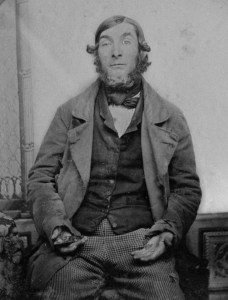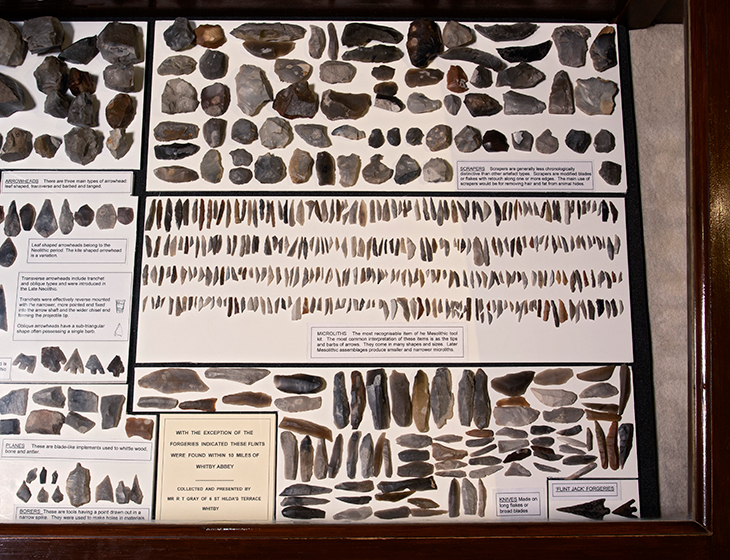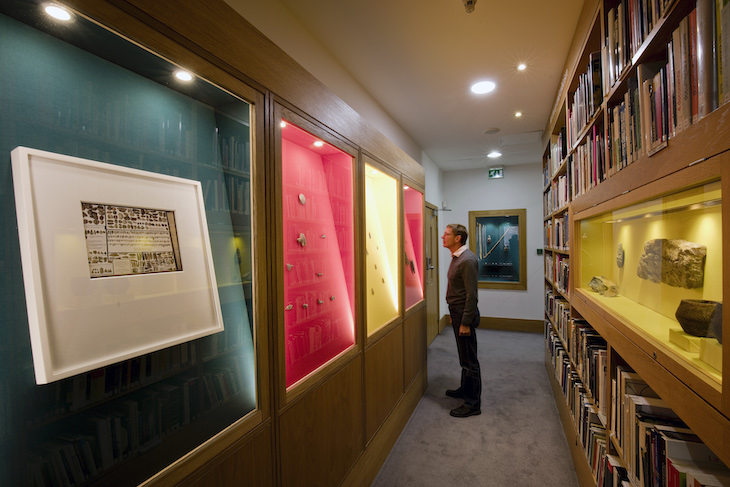For his current exhibition at the Henry Moore Institute, Leeds, the Irish artist Sean Lynch has delved into the exploits of the 19th-century forger Flint Jack – whose fake prehistoric tools and geological specimens found their way into numerous museums.
What do we know about Edward Simpson, or ‘Flint Jack’?
He was born in Carlisle. He was born in Borough in London. He was born in Londonderry. He was born in Yorkshire. Sometimes his father was an army captain; sometimes his father was a sailor on the high seas. He would have a different story for every occasion. We know that he began to haunt the area around Whitby and Scarborough and then, probably in the 1840s – it might have been the 1850s – he learnt the skill of knapping flint.
Photograph in York Museum, possibly depicting ‘Flint Jack’ (c. 1815–c. 1880). Courtesy Henry Moore Institute, Leeds & Ronchini, London

There was such a growth in the antiquities market or the market for archaeological objects at the time, and there was a great desire to collect these objects. And so Jack found a number of collectors who became interested in him. He would come to fledgling museums and he’d say: ‘I was having a drink of water by the river, near the town, and I looked up and there were all these objects sticking up out of the ground. I was told I should show them to you, to see if you might like to buy them.’
He was also sourcing fossils – East Yorkshire is a very rich area for fossils and he began to sell these to farmers, or to other locals, at the moment [in the mid 19th century] when they were just beginning to have a foundational sense of pre-history.
Jack’s relation to that moment is very interesting. You kind of crack him open and the stories fall out. He left Yorkshire in the mid 1850s – he was cast down the road, to London, and then he travelled all through the UK – to Northern Ireland, to Scotland – before he met his downfall, because of the drink. Scholarly people working in museums wrote down some of the stories about him – but there are also huge gaps in the knowledge, about where he was at such and such a time; there’s a lot of misreporting. Increasingly he became a ghost-like figure – and I thought, in putting on the exhibition, that there was an opportunity for mischief in those gaps.
He seems to have been a fantastic showman…
Oh, totally. For example, sometimes his flintheads are much larger than a real flinthead would be – and there are two reasons for that. The first was that it was quicker to make – that he didn’t have to reduce the stone so much in size. And also it would impress people a lot more, to find a larger spearhead.
Installation view of ’The Rise and Fall of Flint Jack’ at the Henry Moore Institute, Leeds (photograph of a display at Whitby Museum). Courtesy Henry Moore Institute, Leeds & Ronchini, London

How does your display tie in with previous exhibitions on the subject of forgery?
The last time Jack was shown in a very public sense was in the British Museum in 1990. The museum had put a forgery on the front of their guide to Roman ceramic lamps in the 1970s, so they had become aware that they needed to make a show about fakes and forgeries; there was one small flinthead by Jack included in that show. I became very interested in the thought that these objects still had a kind of latency – that maybe a larger show could be made about him.
But one of the reasons he left Yorkshire was that his collectors began to realise they were being fooled. They organised an exhibition in the Yorkshire Museum – a collection of all their forgeries, along with some real objects – and they encouraged the farmers around Yorkshire to come into town to look at the exhibition, so that they could then educate themselves about the objects beneath the land.
Exhibition-making is normally about celebration – but this was a show about danger, about exposing a certain fellow as a fraud. I was particularly interested in that – a lot of the objects in ‘The Rise and Fall of Flint Jack’ were shown in that exhibition in the 1850s.
Your exhibition strikes me above all as a celebration of Jack. If Jack is the hero of this story, are museums, in some sense, the fools?
Oh, absolutely. You know, you always have to bite the hand that feeds you. I think that having standardised models to deal with the objects in the world is a very problematic thing, because meaning is shifting all the time. It’s about pointing out that there are contingencies in those models – that objects are there to be played around with.
After things are made, they end up in different scenarios that were never intended for them. Jack’s pieces are sitting in storerooms in museums up and down the UK, but they might still point to things that are useful to discuss. Perhaps 150 years ago wasn’t the time for him – maybe there was a potential that had to wait until now to be realised […] I’m always interested in the idea that all any of us are doing is shepherding material on, just to see what happens to it.
How do the exhibition and its accompanying book play around with the material?
The book thinks about Jack in relation to Michael Heizer, to Henry Moore –sculpture with a capital ‘S’ – but also to the landscape in Yorkshire, to social history and notions of artisanship. I was trying to link Jack with other modalities – it’s not a straight-up history story, and I am not trying to simplify his story down. Rather than putting didactic panels on the wall of the exhibition, I wanted to try and give people a sense that the more you dig, the more might be there for you.
Installation view of ’The Rise and Fall of Flint Jack’ at the Henry Moore Institute, Leeds. Courtesy Henry Moore Institute, Leeds & Ronchini, London

Is this why the exhibition has been mounted in the library at the Henry Moore Institute?
Well, on a super-basic level, I just liked the idea of bringing sharp objects into a library. But I suppose it’s also a kind of negotiation – how Jack might fit in with all the other accumulated knowledge that’s in there. I like thinking of Jack as a ghost – and I liked the idea that you can ignore him here, if you want to. But he’s there in the shadows, hidden among the books on the bookshelves.
‘The Rise and Fall of Flint Jack’ is at the Henry Moore Institute, Leeds, until 29 September. The accompanying book is by Sean Lynch and Jorge Satorre.



